Best Wi-Fi 7 routers of 2024: The future of Wi-Fi is here
These are the best Wi-Fi 7 routers we've tested so far
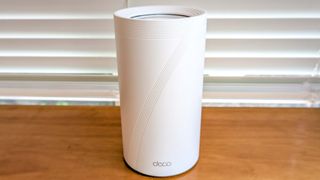
The best Wi-Fi 7 routers offer the fastest speeds possible to give your home network a major upgrade. We can tell you which one is the best for your home or apartment as we started reviewing Wi-Fi 7 routers as soon as they became available and our continuing to add new models to this list as they’re released.
Just like we do with traditional Wi-Fi routers and mesh Wi-Fi systems, we put each Wi-Fi 7 router we review through extensive real-world testing but we also use network benchmarking software as well. This way, we can tell you which ones offer the best range and coverage and which ones are better at sending a signal through walls.
If you’re after a traditional Wi-Fi 7 router, our current top pick is the Asus RT-BE96U thanks to its blazing fast speeds and built-in security software. As for mesh Wi-Fi systems with Wi-Fi 7, the Netgear Orbi RBE973 is the one to beat.
There are already a lot of great Wi-Fi 7 routers for different use cases based on our reviews and we’re working to add even more to this guide. Here’s the best Wi-Fi 7 routers you can buy right now.
The quick list

The Asus RT-BE96U is a blazing fast Wi-Fi 7 router with excellent range and built-in security software that reached a max speed of 1.94 Gbps at close distances.
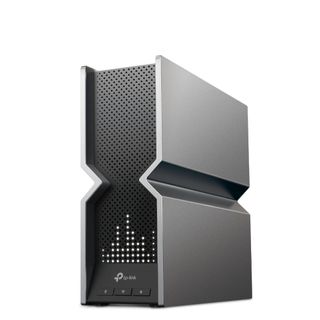
The TP-Link Archer BE800 provides great Wi-Fi 7 performance in a unique form factor that includes a 3-inch LED dot display with a max speed of 1.8 Gbps at close distances.
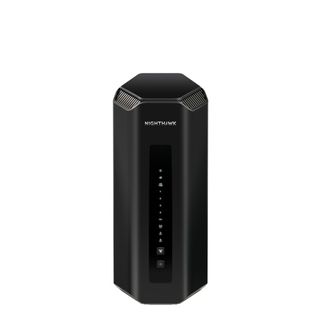
The Netgear Nighthawk RS700S offers good Wi-Fi 7 speeds while really excelling at mid-range with a max speed of 1.7 Gbps up close.
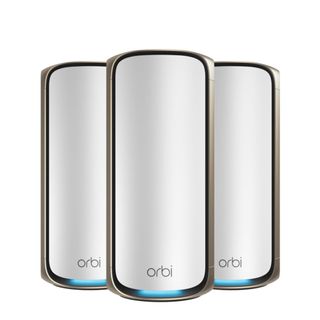
The Netgear Orbi RBE973 offers fantastic Wi-Fi 7 performance in a premium package with a max speed of over 2 Gbps at close distances.
Read more below
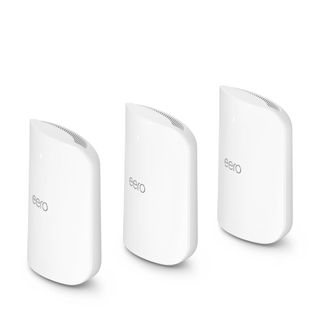
The eero Max 7 is an easy-to-use Wi-Fi 7 mesh router in a brand new form factor for eero that offers good performance with a max speed of 1.78 Gbps at a close distance.
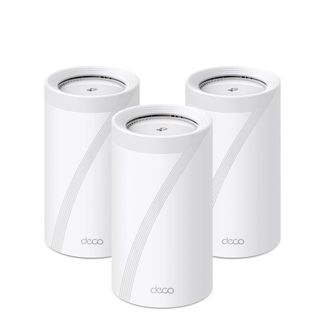
The TP-Link Deco BE85 provides excellent Wi-Fi 7 performance with compatibility for fiber internet with a max speed of 1.7 Gbps at close distances.
Load the next product...
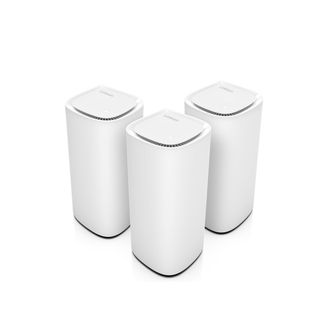
The Linksys Velop Pro 7 is a more affordable Wi-Fi 7 mesh router that has built-in malicious site blocking with a max speed of 916 Mbps at close distances.
The best Wi-Fi 7 routers you can buy today
Why you can trust Tom's Guide
Best Wi-Fi 7 router overall



Specifications
Reasons to buy
Reasons to avoid
The Asus RT-BE96U is a blazing fast Wi-Fi 7 router and also the first device from Asus to incorporate the latest wireless standard. At $699, it's priced similarly to Netgear's Nighthawk RS700S, though it's $100 more expensive than TP-Link's BE800. For the price though, you're getting built-in security software thanks to Asus' AiProtection and this Wi-Fi 7 router can act as both a VPN client and server.
During our testing, the Asus RT-BE96U reached a max speed of 1.94 Gbps at a distance of 15 feet. In total, the router has a maximum range of 105 feet and at a distance of 75 feet, we still saw speeds of 402.1 Mbps. The Asus RT-BE96U also performed well in our wall penetration test where it had a download speed of 1.8 Gbps when our test laptop and the router were separated by a 25 foot room and a wall.
The Asus RT-BE96U has a sleek, all-black design with eight antennas on top of the device which can be repositioned and angled to push its signal further. On the back of the router, there are plenty of ports including a 10 Gbps and a gigabit WAN, a 10 Gbps and three gigabit LAN connections as well as two USB 3.0 ports for moving data across your network. The Asus RT-BE96U is a worthwhile investment if you want an incredibly fast Wi-Fi 7 router that you'll be able to use for years to come.
Read our full Asus RT-BE96U review.
Best Wi-Fi 7 router on a budget



Specifications
Reasons to buy
Reasons to avoid
The Archer BE800 is TP-Link’s first traditional router with Wi-Fi 7 support but instead of going with the same tired old design, the company has done something completely different with its new V-Fold design language. The Archer BE800 is also relatively affordable for a Wi-Fi 7 router at $599, but if you’re on a tight budget, you might want to consider the Archer BE550, which can be had for just $300.
During our tests, the Archer BE800 was able to reach speeds of 1.8 Gbps at a distance of 15 feet when using the 6 GHz band. The router itself has a maximum range of 115 feet but we saw speeds fall to 335 Mbps at 50 feet and at 90 feet, they bottomed out at 19 Mbps. When we tested how well the Archer BE800 could push a Wi-Fi signal through a wall, we saw speeds of 1.2 Gbps at a distance of 20 feet.
Besides its unique design, the Archer BE800 has another trick up its sleeve in the form of a 3-inch, monochromatic LED display that can show the weather, time, text and even emojis. At the back of the device though, you’ll find two 10 Gbps ports (one can also be used as an SPF+ fiber port), four 2.5 Gbps Ethernet ports and a USB 3.0 port. It’s worth noting that if you like the look of this router but wish it had two screens, you’re in luck, as the more premium Archer BE900 sports dual displays. Check out our Archer BE800 vs Archer BE900 face-off for more on this.
Read our full Archer BE800 review
Best Wi-Fi 7 router for long range



Specifications
Reasons to buy
Reasons to avoid
The Nighthawk RS700S is Netgear’s equivalent of TP-Link’s Deco BE800 and even though it may look like a unit from a mesh Wi-Fi system, it’s actually a traditional Wi-Fi router. At $699, it comes in at the same price as the Archer BE900. For the price though, you get a sleek Wi-Fi 7 router that really excels at middle distances where the competition falls short.
In our testing, the Nighthawk RS700S was able to reach a maximum speed of 1.7 Gbps at a distance of 15 feet. Middle distances are where it really excelled: Where other Wi-Fi 7 routers saw significant speed dips, it was able to move 691 Mbps at 50 feet. Even at 90 feet though, it still managed download speeds of 40.6 Mbps and the Nighthawk RS700S has a maximum range of 95 feet.
At the back of the Nighthawk RS700S, you’ll find a 10 Gbps WAN port along with a 10 Gbps LAN port, four gigabit Ethernet ports and a USB 3.2 port. When it comes to the size of this device, it’s about a third smaller than the Archer BE800, though still quite tall for a traditional Wi-Fi router. This tri-band device was also easy and quick to set up and there are lots of configuration options available for those who really want to tweak things.
Read our full Netgear Nighthawk RS700S review
The best Wi-Fi 7 router for mesh



Specifications
Reasons to buy
Reasons to avoid
The Orbi RBE973 is the latest and greatest mesh Wi-Fi system from Netgear and like the Wi-Fi 6E-powered Orbi RBKE963 it replaces, you're paying a premium for excellent performance along with plenty of ports. For instance, a two-pack sells for $1,699 while a three-pack will set you back $2,299. However, if you want a premium mesh router with Wi-Fi 7 that's also future-proof, it could be worth the price depending on your needs and budget.
During our testing, the Orbi RBE973 easily reached speeds of over 2 Gbps at 15 feet from the router. This mesh kit had a maximum range of 95 in our tests but since Wi-Fi 7 uses the 6 GHz band, speeds fell off quickly as we moved our testing laptop farther away from it. At a distance of 50 feet, the Orbi RBE973 provided download speeds of 490 Mbps and at 90 feet, we could only get 25.3 Mbps down. If you do need to connect to this mesh Wi-Fi system from farther away, you'll see better performance if you switch from its 6 GHz band to the 5 GHz band.
One of the things we really like about the Orbi RBE973 is that besides its 6, 5 and 2.5 GHz bands, there's also an extra 5 GHz band dedicated to backhaul between the main router and its satellites. Design wise, this mesh kit is a bit different than other Orbi devices (just like with the eero Max 7 and eero's older mesh routers) as it features a cylindrical design as opposed to the more triangular shape Netgear used to use. As for ports, at the back of the main unit, there's a 10 Gbps WAN port, a 10 Gbps LAN port and four 2.5 Gbps LAN ports. Meanwhile, the satellites only have a single 10 Gbps port and two 2.5 Gbps ports. While we were impressed with the Orbi RBE973's performance, its one-year warranty and 90 days of technical support fall a bit short when compared to the competition.
Read our full Orbi RBE973 review
Best Wi-Fi 7 router for multi-gig



Specifications
Reasons to buy
Reasons to avoid
The eero Max 7 is Amazon’s first Wi-Fi 7 router and like other eero devices, it’s a mesh Wi-Fi system since the company doesn’t actually make any traditional Wi-Fi routers. It’s priced slightly higher than the Deco BE85 at $1,700 for a three-pack or $1,140 for a two-pack. However, eero does sell single unit add-ons for $600 if you want to build out your mesh network later.
During our testing, the eero Max 7 reached a maximum speed of 1.78 Gbps at a distance of 15 feet. However, moving further away from the router saw a major decrease in speeds with 146 Mbps at 50 feet and a paltry 16.8 Mbps at 90 feet. The eero Max 7 did a good job of punching data through a wall with speeds of 789.1 Mbps, 25 feet from the router.
While eero’s past mesh Wi-Fi systems like the eero Pro 6E featured a puck-shaped design, the company has done things a bit differently this time around by going with a design that more closely resembles the Orbi RBKE963. This does allow for more ports at the back;on the rear of the eero Max 7, you’ll find two 10 gigabit Ethernet ports along with two 2.5 gigabit Ethernet ports. There isn’t a USB port for sharing data across your network though. Although the eero Max 7 fell short at middle and long distances in terms of download speeds, you still can’t beat how easy this mesh Wi-fi system is to set up using the eero app. Also, if you want to extend your mesh network further, you can always use a newer Echo Dot as a mesh extender.
Read our full eero Max 7 review
Best Wi-Fi 7 router for fiber



Specifications
Reasons to buy
Reasons to avoid
The Deco BE85 was the first mesh Wi-Fi system with Wi-Fi 7 to hit the market and while it’s priced higher than past TP-Link devices like the Deco XE75, it’s still the cheapest mesh router that supports the latest wireless standard. A two-pack will set you back $1,000 while a three-pack goes for $1,500 but keep in mind, all Deco devices work together so if you have an older mesh Wi-Fi system from TP-Link, you can use it to build out your home network’s coverage area further.
In our testing, the Deco BE85 reached a maximum speed of 1.73 Gbps at a distance of 15 feet. Speeds remained relatively high at 50 feet where we got 790 Mbps down and even at 90 feet away, the Deco BE85 still managed to hit 42.6 Mbps. If you find yourself quite far away from the router, you’ll likely see better performance if you switch to the combo 2.4/5 GHz bands since this mesh router lacks the ability to automatically change bands for peak throughput and you can’t manually select which data channel to use.
At the back of the Deco BE85, you’ll find two 10 Gbps ports (one of which can be used as an SPF+ fiber port), two 2.5 Gbps ports and a USB 3.0 port. Another nice thing about this mesh Wi-Fi system is that all of the units are interchangeable, so any of them can serve as the main router or as a satellite. The Deco BE85’s cylindrical design is similar to previous Deco devices but this time around, there’s a large “7” inscribed on the front to let you know that this is a mesh Wi-Fi system with Wi-Fi 7 support.
Read our full TP-Link Deco BE85 review
Best budget Wi-Fi 7 router for mesh



Specifications
Reasons to buy
Reasons to avoid
Unlike with some of the first Wi-Fi 7-powered mesh routers, the Linksys Velop Pro 7 is much more affordable, though it's still a bit more than your average mesh Wi-Fi system with Wi-Fi 6E. However, you can pick up a three-pack for $900 which is less than half what you'd pay for the same configuration with the Orbi RBE973.
In order to lower the cost of the Velop Pro 7, Linksys did have to cut a few corners. For instance, you only get four gigabit Ethernet ports for your downstream devices but there is a 2.5 Gbps WAN port to connect to your cable modem. While other Wi-Fi 7 mesh routers saw speeds close to 2 Gbps in our networking benchmarks, the Velop Pro 7 topped out at 916.7 Mbps at a distance of 15 feet.
Even if it's not the fastest Wi-Fi 7 mesh router, the Velop Pro 7 does give you all of the other benefits of the latest wireless standard like faster 320 MHz data channels, 4K QAM and Multi-Link Operations. At the same time, you also get some built-in security software in the form of Linksys' Cognitive Security which combines malicious site protection with machine learning-based online safety. The Velop Pro 7 is a good choice if you want a compact, Wi-Fi 7 mesh kit without breaking the bank.
Read our full Linksys Velop Pro 7 review.
Wi-Fi 6 vs Wi-Fi 6E vs Wi-Fi 7
If you’re thinking of upgrading to one of the best Wi-Fi 7 routers, chances are you’ve also come across some Wi-Fi 6 and Wi-Fi 6E devices during your research. While Wi-Fi 7 is the latest and greatest wireless standard, you can save quite a lot by opting for a router that uses one of these older standards instead.
For those still using an older, wireless router that supports the 802.11ac standard (retroactively named Wi-Fi 5), upgrading to a Wi-Fi 6 router could still offer a number of improvements. In addition to a higher maximum data rate of up to 9.6 Gbps, Wi-Fi 6 also brought back the 2.4 GHz band. While the 5 GHz band is much faster, the 2.4 GHz band has better range which is perfect for connected devices that are farther away from your router like your smart home devices or one of the best outdoor security cameras. Having two Wi-Fi bands to work with also makes it easier to set up a guest network for visitors to keep them off of your main Wi-Fi network.
Wi-Fi 6 was released in 2019 but just a year later, Wi-Fi 6E was adopted by the Wi-Fi Alliance and devices supporting it began rolling out. This is the first time in the history of Wi-Fi that there was an incremental upgrade to an existing wireless standard and it very well could be the last time as well. The biggest difference between Wi-Fi 6 routers and Wi-Fi 6E routers is that these newer devices give you access to the new 6 GHz band.
Over the past few years, we’ve seen more and more smartphones, laptops and tablets ship with Wi-Fi 6E support. This means that they can use the 6 GHz band which is less crowded (for now) while your older devices can use the 5 GHz band and your smart home devices can be relegated to the 2.4 GHz band. There is one catch with 6 GHz that you do need to know about: it’s great at short distances but download and upload speeds fall off very quickly the further you move away from your router. If you plan on working in the same room with your router, the 6 GHz band is the way to go, but if you want to go to the couch or sit at the kitchen table, you’ll likely have a better experience on the 5 GHz band.
Wi-Fi 7 supports the same amount of wireless bands as Wi-Fi 6E but Wi-Fi 7 routers can make use of Multi-Link Operation (MLO) technology. This allows your devices to connect to as well as send and receive data from multiple Wi-Fi bands simultaneously. Besides the inclusion of wider data channels, MLO is one of the main reasons Wi-Fi 7 is so much faster than its predecessors.
How to choose the best Wi-Fi 7 router for your home
When it comes to picking the right Wi-Fi 7 router for your home network, there are a number of factors you need to consider first including price, range, ports and design.
Price: The first Wi-Fi 7 routers came to market in the summer of 2023 and as they are the latest and greatest home networking tech, they’re still priced significantly higher than their Wi-Fi 6 or Wi-Fi 6E equivalents. This is starting to change now that companies like Netgear, TP-Link, eero and others have released their flagship devices. For instance, you can pick up TP-Link’s budget Archer BE9300 Wi-Fi 7 router for just $249 at Walmart right now.
Based on the Wi-Fi 7 routers we’ve reviewed this far, you should expect to pay around $500 to $600 for a traditional Wi-Fi 7 router whereas mesh routers with Wi-Fi 7 typically cost anywhere from $1,000 for a two-pack all the way up to $2,300 for a three-pack. If you do decide to go with a mesh Wi-Fi system though, remember you can buy a two-pack now and add an additional satellite later to lower the up-front costs.
Range: Most Wi-Fi 7 routers have a range of around 2,000 square feet. If you live in an apartment or a smaller, one-story home, this should be more than enough for your needs. However, if you live in a large home or one with an odd layout with multiple stories or interior walls made from brick, opting for a mesh Wi-Fi system is your best bet.
While you can use one of the best Wi-Fi extenders to increase the range of your home network, they require that you manually switch networks, plus there aren’t any Wi-Fi extenders that support Wi-Fi 7 just yet. Likewise, you can also use a powerline extender to extend your network further using your home’s electrical wiring but this can be hit or miss. Paying more for a mesh Wi-Fi system makes more sense in the long run, especially if you don’t want to deal with Wi-Fi dead zones or extenders.
Ports: The number of ports that you should look for on the back of your router depends on how many devices you want to connect using Ethernet. Even if you only plan on connecting one or even a few computers directly to your router, some smart home devices, like Philips Hue lights, come with a hub that needs to be connected via Ethernet. This is why it’s always good to have a few more Ethernet ports than you actually plan on using. You can always buy a network switch later to add more Ethernet ports if you need to but having four or more ports is always a good idea.
In addition to Ethernet ports, some Wi-Fi 7 routers have USB ports too. These USB ports can be really useful if you want to connect one of the best flash drives or even an external hard drive to your router and access the files stored on them across your home network.
Design: As you’re spending your own money on a Wi-Fi router instead of renting one from your ISP, you’re going to want to get a device that you like the look of since you’re likely going to be using for the next three to five years. If you plan on having your router out in the open, then its design will be more important than if you want to tuck it away in a corner. Likewise, some Wi-Fi routers have aimable antennas that you can physically manipulate to spread out your router’s Wi-Fi signal while others have their antennas built-in.
If you plan on going with a traditional Wi-Fi router, its design is less important than with a mesh Wi-Fi system. This is because mesh Wi-Fi systems consist of a main unit that serves as the router but there are also satellites that you need to spread throughout your house for whole home Wi-Fi coverage.
How we test Wi-Fi 7 routers
As part of our networking reviews at Tom’s Guide, we thoroughly test and evaluate each of the Wi-Fi routers we review. From detailing the setup procedure to drilling down into the customizability of each router, we spend plenty of hands-on time before publishing our reviews.
In order to gauge the performance of each of the Wi-Fi 7 routers on this list, we do a combination of real-world testing and testing using networking benchmarks like IXChariot and iPerf3. We start a range of 15 feet away from the router to check download and upload speeds up close before going through the exact same tests at a distance of 50, 75 and 90 feet in order to determine a Wi-Fi router’s maximum range.
After we’ve finished our throughput tests, we also put each Wi-Fi 7 router through real-world tests. During this round of testing we connect a number of devices including laptops, TVs, smartphones and tablets while streaming a number of games, TV shows and movies simultaneously to see how well each device performs under strain.
As there weren’t many Wi-Fi 7 client devices available when we started reviewing Wi-Fi 7 routers this year, we used a OnePlus 11 as it was the first smartphone to support the latest wireless standard. It took a while but the best laptops are beginning to support Wi-Fi 7 and we’re now using the Acer Swift Edge 16 for network benchmarking as well. All of our Wi-Fi router testing is done in a 3,500 square foot home with multiple floors. When it comes to testing mesh Wi-Fi systems that support Wi-Fi 7, we spread the satellites out between floors to see just how well these routers can push a Wi-Fi signal between floors.
Since Wi-Fi routers are electronic devices after all, we also take a close look at how much energy they consume and see if there are any power-saving modes to make them more economical to run. From here, we calculate how much it will cost you to run each device per year based on the national average of 16 cents per kilowatt hour of electricity.
For more information on how we test networking devices, check out our guide on how we test Wi-Fi routers along with our more general how we test page for Tom's Guide.
Check out all of our home networking coverage:
Best mesh routers | Best Wi-Fi 6 routers | Best gaming routers | Best Wi-Fi extenders | Best powerline extenders | Best cable modems
Sign up to get the BEST of Tom's Guide direct to your inbox.
Get instant access to breaking news, the hottest reviews, great deals and helpful tips.

Anthony Spadafora is the security and networking editor at Tom’s Guide where he covers everything from data breaches and ransomware gangs to password managers and the best way to cover your whole home or business with Wi-Fi. Before joining the team, he wrote for ITProPortal while living in Korea and later for TechRadar Pro after moving back to the US. Based in Houston, Texas, when he’s not writing Anthony can be found tinkering with PCs and game consoles, managing cables and upgrading his smart home.